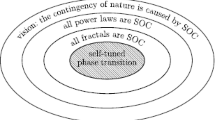Abstract
Self-organized criticality (SOC) has been widely adopted as a useful paradigmatic generalization to capture an array of observations found to be intrinsic in many natural and human-made systems. It often manifests itself in the form of dynamic metastable patterns that are not attributable to any constituent element of the system. As our world becomes increasingly network centric, assessment of the emergent unpredictable fluctuations increasingly play an important role in understanding the system dynamics of society and economics. To date, complexity and SOC lack a systematic convergence of theoretical approaches and experimental methodologies. The attitude of many hard sciences in relation to complex systems can often be described as “the elephant in the room,” a metaphorical idiom for an obvious truth that is largely ignored by scientists, even if recognized as critical in assessing risk and inherent uncertainty. Here we provide a brief background on the roles of SOC and emergence that seem to spontaneously appear with a plethora of spatial-temporal fluctuations on all scales. We propose that a deeper understanding of these phenomena requires a convergent effort of the sciences, arts, and humanities both in research and education. Further, it is proposed that a unified approach is necessary to achieve a more quantifiable, analytical, and predictive methodology to determining risk and resilience in complex systems with the goal of better understanding the world around us.
Similar content being viewed by others
References
Anderson PW (2011) More and different: notes from a thoughtful curmudgeon. World Scientific, Singapore, New Jersey
Ashby WR (1947) Principles of the self-organizing dynamic system. J Gen Psychol 37:125–128
Bak P (1999) How nature works: the science of self-organized criticality. Copernicus, New York
Bak P, Paczuski M (1995) Complexity, Contingency, and Criticality. Proceedings of the National Academy of Sciences 92:6689–6696
Barabasi A-L (2012) The network takeover. Nat Phys 8:15–16
Binder PM (2009) The edge of reductionism. Nature 459:332–333
Chialvo D (2014) In: A fundamental theory to model the mind, Jennifer Ouellette. Quanta Magazine, 3 Apr 2014. https://www.quantamagazine.org/20140403-a-fundamental-theory-to-model-the-mind/
De Wolf T, Holvoet T (2005) Emergence versus self-organisation: different concepts but promising when combined. In: Engineering self-organizing systems, Lecture notes in computer science. Springer, Berlin/Heidelberg
Gimzewski JK, Joachim C (1999) Nanoscale science of single molecules using local probes. Science 238(5408):1683–1688
Hazen R (2005) Genesis: the scientific quest for life’s origins. Joseph Henry Press, Washington, DC
Jensen HJ (1998) Self-Organized Criticality: Emergent Complex Behavior in Physical and Biological Systems. Cambridge University Press, Cambridge.
Johnson BR, Lam SK (2010) Self-organization, natural selection, and evolution: cellular hardware and genetic software. Bioscience 60(11):879–885
Kari L, Rozenberg G (2008) The many facets of natural computing. Commun ACM 51(10):72–83
Langton CG (1990) Computation at the edge of chaos: phase transitions and emergent computation. Physica D 42:12–37
LeCun Y, Bengio Y, Hinton G (2015) Deep learning. Nature 521:436–444
Modha DS, Rajagopal A, Esser SK, Ndirango A, Sherbondy AK, Singh R (2011) Cognitive computing. Commun ACM 54(8):62–71
Nettesheim S, von Oertzen A, Rotermund HH, Ertl G (1993) Reaction diffusion patterns in the catalytic CO-oxidation on Pt(110)- front propagation and spiral waves. J Chem Phys 98:9977
Prigogine I (1997) The end of certainty. Free Press, New York
Proctor JD, Larson BMH (2005) Ecology, complexity, and metaphor. Bioscience 55(12):1065–1068
Stieg AZ, Avizienis AV, Sillin HO, Martin-Olmos C, Aono M, Gimzewski JK (2012) Emergent criticality of complex turing B-type atomic switch networks. Adv Mater 24:286–293
von Neumann J (1988) The principles of large scale computing machines. IEEE Ann Hist Comput 10:243
Weiner N (1961) Cybernetics or control and communication in the animal and the machine, 2nd edn. MIT Press, New York, Cambridge
Acknowledgments
JG thanks the Semiconductor Research Corporation (SRC); Japanese World Premiere Initiative program (WPI); International Center for Material Nanoarchitectonics (MANA) and DARPA’s Physical Intelligence program for inspiration and funding. VV acknowledges “Mapping Acoustic Sensor Networks” research, NSF grant no. IIS-1125423 (Charles Taylor, PI). We thank Renato Aguilera for useful discussions.
Author information
Authors and Affiliations
Corresponding author
Editor information
Editors and Affiliations
Rights and permissions
Copyright information
© 2015 Springer International Publishing Switzerland
About this entry
Cite this entry
Gimzewski, J.K., Stieg, A.Z., Vesna, V. (2015). Self-Organization and Emergence of Dynamic Systems. In: Bainbridge, W., Roco, M. (eds) Handbook of Science and Technology Convergence. Springer, Cham. https://doi.org/10.1007/978-3-319-04033-2_74-1
Download citation
DOI: https://doi.org/10.1007/978-3-319-04033-2_74-1
Received:
Accepted:
Published:
Publisher Name: Springer, Cham
Online ISBN: 978-3-319-04033-2
eBook Packages: Springer Reference Computer SciencesReference Module Computer Science and Engineering




